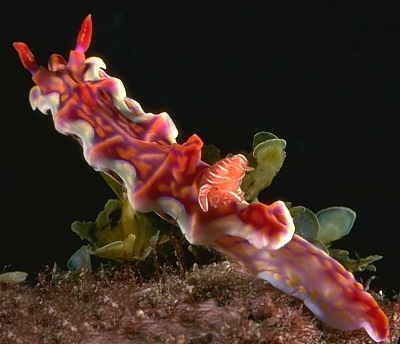
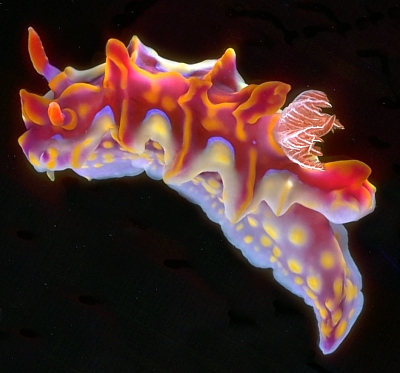
Ceratosoma flavicostatum
(Baba, 1940)
Order: NUDIBRANCHIA
Suborder: DORIDINA
Superfamily: EUDORIDOIDEA
Family: Chromodorididae
DISTRIBUTION
Western Pacific
PHOTO
Upper: Coffs Harbour region, northern New South Wales, November 1990. AM C164521. Lower: Jibbon Head, Port Hacking, Sydney, NSW, Nov. 1981. Photos: Bill Rudman.
Note added 4 July 2007: The name is changed today from C. flavicostata to C. flavicostatum - see message #20101.
This species has often been identified as Miamira magnificum Eliot, 1910, but there is considerable confusion surrounding the identity of that species. Until now I have, like Baba & Hamatani (1974), considered all the various coloured forms of 'Miamira' to be part of one variable species of Ceratosoma [see message #19853]. As outlined in a separate message [#19854] I am now recognising Ceratosoma sinuatum and Ceratosoma flavicostatum as separate species, and separating a few western Indian Ocean animals as possible specimens of C. magnificum.
Ceratosoma flavicostatum usually has a broad whitish margin to the mantle and the rest of the mantle is a reddish brown or even purple with orange rounded ridges. The rhinophores usually lack white markings, but the gills are edged with opaque white lines. The front of the mantle does not have a prominent central lobe. In both this species and C. sinuatum there can be up to three large tubercles in the dorsal midline between the gills and the rhinophores. If present, the most posterior one, just in front of the gills, is the longest, often standing much taller than the gills.
C. flavicostatum was first described from Japan and has been reported since from many parts of the tropical western Pacific. The name flavicostatum [= yellow ridges] indicates one of the most obvious characters of this species.
-
Baba, K. (1940) Miamira flavicostata n.sp., a nudibranchiate mollusc from Amakusa, Japan. Zoological Magazine, Japan 52(6), 239-240.
-
Baba, K & Hamatani, I. (1974) On the synonymy of Miamira sinuata (van Hasselt, 1824) from Japan (Nudibranchia: Dorididae: Miamirinae). Venus, The Japanese Journal of Malacology 33 (2, August), 81-84.
-
Eliot, C.N.E. (1910) Nudibranchs collected by Mr. Stanley Gardiner from the Indian Ocean in H.M.S. Sealark. Reports of the Percy Salden Trust Expedition to the Indian Ocean in 1905, under the leadership of Mr. J. Stanley Gardiner, M.A. Transactions of the Linnean Society, Zoology, series 2, 13(2), 411-439, Pl. 25.
-
Valdes, A. & Gosliner, T. (1999) Reassessment of the systematic status of Miamira Bergh, 1875 and Orodoris Bergh, 1875 (Nudibranchia; Chromodorididae) in light of phylogenetic analysis. Journal of Molluscan Studies, 65:33-45.
Bill Rudman
Authorship detailsRudman, W.B., 2007 (April 30) Ceratosoma flavicostatum (Baba, 1940). [In] Sea Slug Forum. Australian Museum, Sydney. Available from http://www.seaslugforum.net/find/ceraflav
Related messages
Re: Ceratosoma flavicostatum feeding
June 10, 2008
From: Teresa Zuberbühler
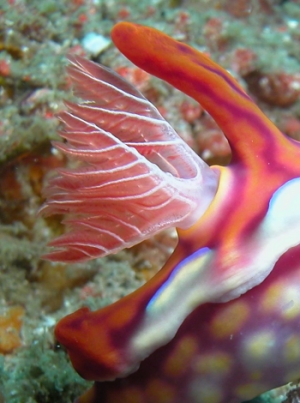
Concerning message #20056:
Dear Bill
I thought you might like some close-ups of the gills of Ceratosoma flavicostatum which are edged with opaque white lines, so you can add them to your Fact sheet.
Didn't realize, the name had changed - now I have to change all the labelings of my photos!!!
Locality: Komodo islands, 20 m, Indonesia, Pacific, July 2003, Patch reef . Photographer: Teresa (Zubi) Zuberbühler.
Greetings
Zubi
webmaster@starfish.ch
Zuberbühler, T., 2008 (Jun 10) Re: Ceratosoma flavicostatum feeding. [Message in] Sea Slug Forum. Australian Museum, Sydney. Available from http://www.seaslugforum.net/find/21607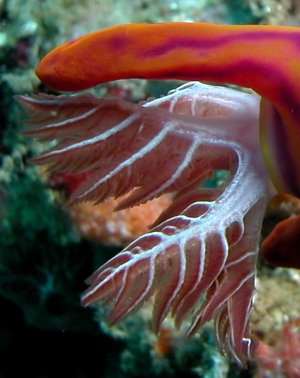
Thanks Zubi,
Best wishes,
Bill Rudman
Coincidental occurrence of Ceratosoma flavicostatum & S. ornatum
September 6, 2007
From: David Mullins
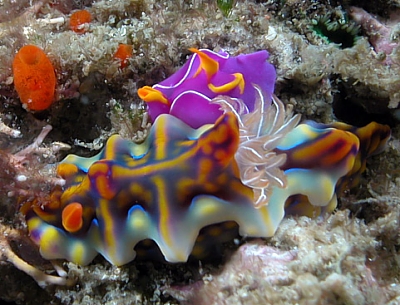
Dear Bill,
Ceratosoma flavicostatum & Sagaminopteron ornatum
These 2 photos were taken at the same site and depth 3 years apart almost to the day. I was going through my pics and cataloguing them when I noticed that the top photo taken 14 August 2004 was very similar to one I remembered taking 2 weeks ago,18 August 2007, bottom photo.
Putting aside the incredible coincidence of date and place (which I can't)I have a question for you. I don't really expect an answer except to say that they might have similar food preferences and that I dive too often and take too many pics so it was bound to happen.
Locality: S.E. corner, Old Woman Island, Maroochydore,, 10 metres, Queensland, Australia., Pacific Ocean, 14 August 2004 & 18 August 2007, rocky reef. Length: 45 mm & 15 mm. Photographer: David Mullins.
The question is: do you believe there are any interspecific associations in the Opisthobranch world? Given that on both occasions the different species depicted here are seen in exactly the same relative position to each other, one really wonders at first if there is.
I don't know what you can do with this other than put it in the anecdotal file. Enjoy.
Regards,
David Mullins.
david@nudibranch.com.au
Mullins, D.A., 2007 (Sep 6) Coincidental occurrence of Ceratosoma flavicostatum & S. ornatum. [Message in] Sea Slug Forum. Australian Museum, Sydney. Available from http://www.seaslugforum.net/find/20587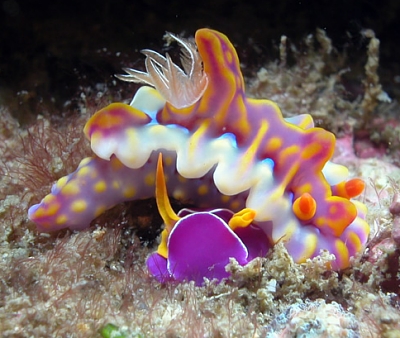
Dear David,
I have changed your identification of the Ceratosoma from C. magnificum. Have a look at my message #19854 where I discuss this name and suggest we should identify your animal as C. flavicostatum.
Finding these two species together does seem an amazing coincidence, but there may in fact be a reason for it. Most species of Ceratosoma feed on dysideid sponges, and we have one record [#19277] suggesting it does as well. Many species of gastropterid, including Sagaminopteron ornatum, are often found associated with dysideid sponges, and some authors have suggested they feed on them. I don't agree myself because their teeth and foregut do not appear to be designed for feeding on sponges. I suspect that like species of Trapania, which are also often found on sponges, that they are feeding on some animal which is itself associated with sponges. I know that compared with some of the great unanswered mysteries in the world, knowing what gastropterids eat is not very high in the priority list, but it is one of those nagging mysteries I would love to see answered.
Best wishes,
Bill Rudman
Re: Ceratosoma flavicostatum feeding
July 5, 2007
From: Leanne & David Atkinson
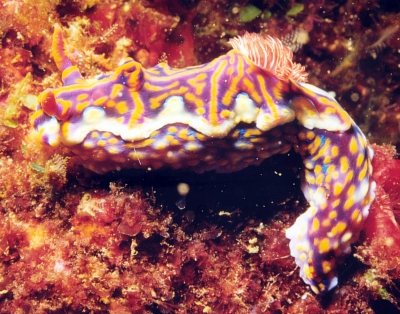
Concerning message #19277:
Hi Bill,
This is a beautiful nudibranch and the name change to Ceratosoma flavicostata doesn't seem to keep that reference to it being magnificent. Does flavicostata have a meaning or is it named after someone? This one doesn't seem to be eating but you sometimes see more in a picture than we do. You don't have one yet from the Coffs Harbour area so thought we would add this one. We found it on the roof of a ledge.
Locality: E Gutters, North West Solitary Island, Solitary Island Marine Park, 10 metres, Northern New South Wales, Australia, Pacific, 15 September 2000, on the roof of a ledge in a shallow rocky reef strong surge area with lots of filter feeder growth. Length: approximately 90 mm. Photographer: Leanne & David Atkinson.
Best wishes,
Leanne & David Atkinson
atk@hunterlink.net.au
Atkinson, L. & D., 2007 (Jul 5) Re: Ceratosoma flavicostatum feeding. [Message in] Sea Slug Forum. Australian Museum, Sydney. Available from http://www.seaslugforum.net/find/20056Dear Leanne & David,
Sorry I can't see anything food-related either.
Concerning the name. I'm sorry to announce a further confusion. It should be flavicostatum. I've explained why in a separate message [##20101]. Concerning the name's meaning, the flavi - comes from Latin for yellow and costatum from latin for a rib. So basically it refers to the yellow rib-like ridges down each side of the mantle. I agree it is not as upbeat as 'magnificum'
Best wishes,
Bill Rudman
Ceratosoma flavicostata feeding
April 30, 2007
From: Danny Van Belle

Dear Bill,
Here I've got some pictures of a nudibranch which is named 'Ceratosoma magnificum' at several webpages.
Locality: Komodo National park - Pink Beach, 10 metres, Indonesia, Indian ocean, 09 august 2006, Reef. Photographer: Anja Flick & Stephen Childs.
However I can't find a 100% sure confirmation on the species list here.
Can you help me out.
Best regards
Danny Van Belle
Marine Wildlife Videographer
www.dannyvanbelle.com
danny.van.belle@skynet.be
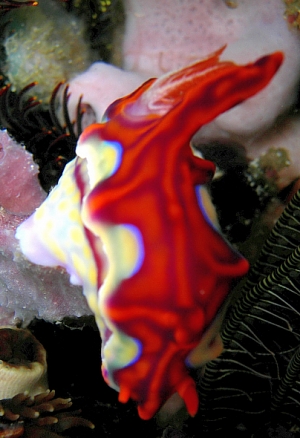
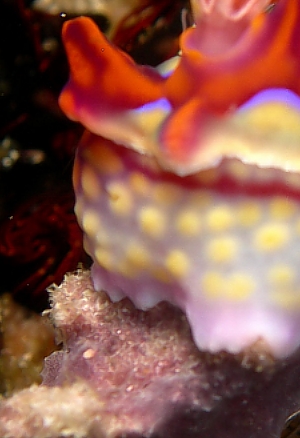

Dear Danny,
I have been avoiding these animals which we used to call 'Miamira ' for some time as they are in a bit of a mess. But your photos, which show two animals on the same sponge, spurred be into activity, because they are the first identifiable sponge records I have of these animals. So as not to repeat myself, have a look at message #19854 where I discuss why I think we should identify this species as Ceratosoma flavicostata rather than C. magnifica.
Of equal interest to me is the sponge. I am pretty sure there are signs of feeding in the middle right and lower photos. You can also see the characteristic structure of a dysideid sponge in the middle right photo, which correlates well with feeding information I have on other species of Ceratosoma.
Best wishes,
Bill Rudman
Ceratosoma sinuata from Queensland
July 14, 2003
From: Gary Cobb


Hi Bill!
Can you tell me what this beautiful nudibranch is? I can not believe its
colours and shape!
- northeast tip of Old Woman Is off the Sunshine Coast, Queensland, Australia
- 9m depth
- date 8-6-03
- 20 degree water
- bottom varies rock, coral and little sand
Look forward to your response!!
Thanks,
Gary Cobb
gary@cobb.com.au
Cobb, G., 2003 (Jul 14) Ceratosoma sinuata from Queensland. [Message in] Sea Slug Forum. Australian Museum, Sydney. Available from http://www.seaslugforum.net/find/10272Note added 30 April 2007: Until now on the Forum this species has been considered a form of C. sinuata [see message #19854]. It is now recognised as C. flavicostata.
Dear Gary,
This is what we are at present callingCeratosoma sinuata. As you will see from the Fact Sheet and other messages, this purplish colour 'form' used to be considered a distinct species, Miamira flavicostata, and a green colour 'form' was called Miamira sinuata. I am happy with the two being moved to the genus Ceratosoma, but I am still a bit hesistant about lumping them both into one species
Best wishes,
Bill Rudman
Sprinting Ceratosoma sinuata
October 22, 2002
From: Sabine Noack

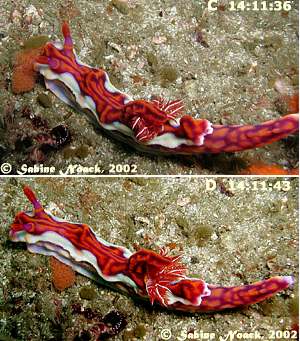
Dear Bill,
Most sea slugs I've seen so far were either sitting or moving rather slowly.
ThisCeratosoma sinuata was kind of sprinting across the reef (from A to D in 35 seconds).
Is there any news about the Ceratosoma sinuata / flavicostata species ?
Sabine
dive@snoack.de
Noack, S., 2002 (Oct 22) Sprinting Ceratosoma sinuata. [Message in] Sea Slug Forum. Australian Museum, Sydney. Available from http://www.seaslugforum.net/find/8229Note added 30 April 2007: Until now on the Forum this species has been considered a form of C. sinuata [see message #19854]. It is now recognised as C. flavicostata.
Thanks Sabine,
You certainly saw it in a hurry - definitely moving more like a flatworm than a slug. Concerning how many species in the Ceratosoma sinuata / flavicostata group, I'm afraid I have nothing to report.
Best wishes,
Bill Rudman
Ceratosoma magnifica trailing
January 10, 2002
From: Ákos Lumnitzer
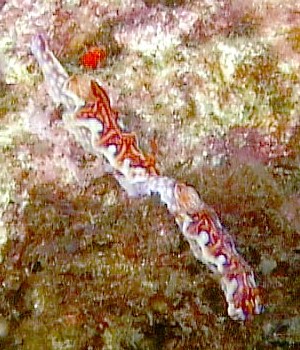
Hi Bill,
Hope you had a great 2001 and look forward to an even better 2002.
Just letting you know, I was out at Shark Point this morning dive [north side of Clovelly Bay, Sydney, Australia] yesterday [5 January 2002] and observed twoCeratosoma magnifica together in the same manner as Risbecia tryoni would tail-gate one another. There was also a third specimen about 30cm away. Here is a still from George Evatt's video recording.
The slugs were on the same rock as they have been for the last three years, but now the grey sponge is ALL gone. Maybe the nudies ate it all? I am unsure as there was about a section of sponge measuring 150mm by 250mm.
Isn't tail-gating a characteristic of the Risbecia clan only (R. tryoni to be precise) or do other nudies behave in a similar way.
Regards
Ákos Lumnitzer
alumnitzer@total-logistics.com.au
Lumnitzer, A., 2002 (Jan 10) Ceratosoma magnifica trailing. [Message in] Sea Slug Forum. Australian Museum, Sydney. Available from http://www.seaslugforum.net/find/5907Note added 30 April 2007: Until now on the Forum this species has been considered a form of C. sinuata [see message #19854]. It is now recognised as C. flavicostata.
Dear Akos,
An interesting observation. This 'trailing' behaviour is indeed a charcteristic of all species of Risbecia but it appears that some other sea slugs also do the same thing. If you use the SEARCH for 'trailing' on the Forum you will get a list of examples which have been reported here. I think you mentioned in an earlier message that you thought you had seen this pecies 'trailing'. I'm glad to see a photo of it.
Best wishes,
Bill Rudman
Ceratosoma sinuata from Indonesia
January 16, 2001
From: Ken Knezick

Among my u/w shots from a recent dive cruise to Komodo National Park, Indonesia is that of a nudibranch I have yet to find in a guide book. It is such a bizarre and beautiful creature, for the moment, I am calling it my "nuclear nudibranch."
I have been directed to the Sea Slug Forum resource by Ms. Anne DuPont, who suggested you might be able to provide me with a more accurate I.D.
Thanks & regards,
Ken Knezick
Island Dreams
ken@islandream.com
Knezick, K. , 2001 (Jan 16) Ceratosoma sinuata from Indonesia. [Message in] Sea Slug Forum. Australian Museum, Sydney. Available from http://www.seaslugforum.net/find/3516Note added 30 April 2007: Until now on the Forum this species has been considered a form of C. sinuata [see message #19854]. It is now recognised as C. flavicostata.
Dear Ken,
Your animal is one of the colour forms of a nudibranch we now callCeratosoma sinuata. It used to belong in its own genus, Miamira, until recently, so you may find it under that name in some books. Have a look at the other photos on this page to get an idea of the colour variation.
best wishes,
Bill Rudman.
Re: Left-handed Ceratosoma sinuata
October 27, 2000
From: Donata P. & Akos L.
Note added 30 April 2007: Until now on the Forum this species has been considered a form of C. sinuata [see message #19854]. It is now recognised as C. flavicostata.
Dear Bill,
We are 100% sure that theCeratosoma sinuata at Kurnell, the really big "boy", is actually hanging on to the tail of the specimen in front. If you perhaps thought the greyish matter in the top right-rear is the other one's body, it was a sponge, perhaps a similar species like the one on a particular Shark Point rock in 22m, where our regulars have been turning up.
Regards
Akos & Donata
dna72@softhome.net
Lumnitzer, A. & Piotrowska, D. , 2000 (Oct 27) Re: Left-handed Ceratosoma sinuata. [Message in] Sea Slug Forum. Australian Museum, Sydney. Available from http://www.seaslugforum.net/find/3240Dear Akos & Donata,
I guess one was either being curious or perhaps it shows the trailing behaviour which has been reported in most species of Risbecia. Something to look out for when you come across a pair, or more, of this species together.
Best wishes,
Bill Rudman
Ceratosoma sinuata - magnifica form
October 25, 2000
From: Akos L. & Donata P

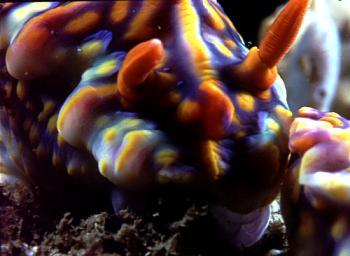
Note added 30 April 2007: Until now on the Forum this species has been considered a form of C. sinuata [see message #19854]. It is now recognised as C. flavicostata.
Hello again,
The UPPER PHOTO is the other beastie from Shark Point, Clovelly, Sydney, the same year (1998-1999).
This is a specimen on a different rock from theCeratosoma sinuata colour forms.
The LOWER PHOTO is from the Steps, at Kurnell, Sydney. This specimen is the really large one in one of my previous messages. I took this shot with a NIKONOS III and a 2:1 xt tube, giving me double life-size magnification on the slide.
As you'll note, this slug is somehow "hanging on" to another C. sinuata in front of its head.
Regards
Akos & Donata
dna72@softhome.net
Lumnitzer, A. & Piotrowska, D. , 2000 (Oct 25) Ceratosoma sinuata - magnifica form. [Message in] Sea Slug Forum. Australian Museum, Sydney. Available from http://www.seaslugforum.net/find/3227Dear Akos & Donata,
Thanks for the photos. it is helping to build up quite a good picture of the various colour forms. Concerning the two 'hanging on' in the lower photo. I thought perhaps they were mating but if that were the case then they are both 'left-handed' or else the photo is reversed as the genital apparatus is on the right side of the body.
Best wishes,
Bill Rudman.
Ceratosoma sinuata - how long-lived?
October 19, 2000
From: Donata P. & Akos L.
Note added 30 April 2007: Until now on the Forum C. flavicostata has been considered a form of C. sinuata [see message #19854]. It is now recognised as distinct.
Hi Bill,
We saw quite a few large, one about 10-12cm long,Ceratosoma sinuata (magnificent colour form), on a rock at Kurnell last summer/ autumn. Just yesterday, 15 October, 2000, two of our friends have seen a C. sinuata (sinuata form) on the very same rock. We have personally observed the two colour forms previously at Shark Point, Clovelly on the very same two rocks, which are about 50m apart over the last two summers.
Could it be possible that since the adults have obviously found a great feed, they've laid their eggs and these hatched some time later? I mean, we have not seen the adults at either of the two dives for around six months. I think it would be too much of a coincidence that the new specimens pop up in the very same location.
Only on one of the Shark Point rocks did we find eggs, not on the other rock, nor at Kurnell. Well, if there were more eggs, they must have been pretty inconspicous.
Wouldn't the larvae from the hatched eggs still "enjoy" the planktonic stage? If somehow they do, then it may just be a total fluke that they landed on the same rocks two years in a row.
Any comments?
Donata & Akos
dna72@softhome.net
Piotrowska, D. & Lumnitzer, A. , 2000 (Oct 19) Ceratosoma sinuata - how long-lived?. [Message in] Sea Slug Forum. Australian Museum, Sydney. Available from http://www.seaslugforum.net/find/3185Dear Donata & Akos,
I suspect this animal is an annual, lasting only about a year, but we do not know much about the lifecycles of most nudibranchs.
In species with no free-swimming larval stage, such as Chromodoris tasmaniensis, then the young are often found clustered together on the food sponge of their parent. Similarly there are species with a very abbreviated larval life which also can mean that a species can stay in one locality for a number of generations. But I don't think C. miamira falls into either of those categories. Its eggs are numerous and small, so I suspect it has relatively long-lived veliger larvae. To find adults regularly at one spot means that either they live longer than one year (and hide for part of it) or there is something that attracts the larvae each year to settle at that spot. The possibility is that it is a good place for their food sponge, which may live for many years.
The other possibility is that it is a coincidence. By bet would be that the food sponge likes the spot and has survived there for a number of years.
Best wishes,
Bill Rudman.
Miamira from New South Wales
April 13, 1999
From: Scott Jamieson
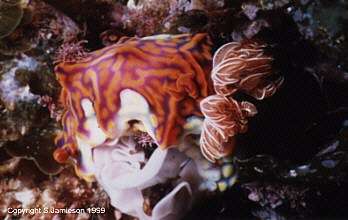
Hi
I need a name for this beast. I found this beautiful animal (about 25 mm long) found at Julian Rocks, New South Wales in 16m of water - laying eggs.
Thanks,
Scott Jamieson
diver71@hotmail.com
Jamieson, S., 1999 (Apr 13) Miamira from New South Wales. [Message in] Sea Slug Forum. Australian Museum, Sydney. Available from http://www.seaslugforum.net/find/768Note added 30 April 2007: Until now on the Forum this species has been considered a form of C. sinuata [see message #19854]. It is now recognised as C. flavicostata.
Dear Scott,
This is Miamira sinuata a brilliantly coloured animal which is not uncommon in northern New South Wales. It lays white to pale blue or purple egg ribbons.
I'm afraid I can't see enough detail in the other two scans you sent. If you can send larger scans I will have a better chance of identifying the species.
Best wishes,
Bill Rudman.
Photo of Miamira at Point Cartwright
May 26, 1998
From: Wayne Ellis
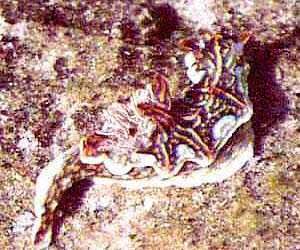
Bill,
Here is a photo of mine of Miamira that was taken at Point Cartwright, Mooloolaba, southern Queensland. on the 19 January 1998. It was found intertidally by Robyn Oxenham.
Regards,
Wayne Ellis
glaskin@ozemail.com.au
Ellis, W., 1998 (May 26) Photo of Miamira at Point Cartwright. [Message in] Sea Slug Forum. Australian Museum, Sydney. Available from http://www.seaslugforum.net/find/78Note added 30 April 2007: Until now on the Forum this species has been considered a form of C. sinuata [see message #19854]. It is now recognised as C. flavicostata.
This is Miamira sinuata, fairly common throughout the Indo-West Pacific. There are a number of colour forms which have been given distinct names such as Miamira nobilis, Miamira magnifica and Miamira flavicostata. Some authors consider Miamira to belong to the Chromodorididae or to be very closely related.
Bill Rudman
